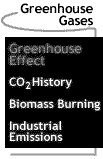

 |
Greenhouse Gases: The Greenhouse Effect The temperature of the air at Earth's surface is the result of many different heat transfer processes. The only source of heat for Earth is the sun. The average radiactive flux reaching the top of the atmosphere from the sun over a day-night cycle is 342 W/m2. This is enough energy to melt 1 kg of ice every 17 minutes. Much of this radiation is reflected back into space by water vapor, clouds, dust particles, and Earth's surface. The amount of light reflected by an object is called its albedo. Clouds and snow have a high albedo (40-90%), while vegetation has a small albedo (10-15%). Because of the albedo of the clouds and Earth's surface, 30% of the incoming solar energy is reflected back into space (see figure).
All objects emit or radiate energy in the form of electromagnetic waves as a function of their temperature. The amount of energy radiated is described by Stefan's law. The higher an object's temperature, the more energy it radiates. You know the burner on a stove is hot because it glows red. Because of the sun's temperature, it radiates primarily in the visible and ultraviolet regions of the electromagnetic spectrum. Earth's temperature is much lower and radiates in the infrared region. An important feature of Earth's atmosphere is that it is transparent to visible light, but certain components of the atmosphere absorb infrared radiation. These components of the atmosphere, called greenhouse gases, consist primarily of water vapor, CO2, CH4, NO2, O3 , and various CFCs and HCFCs. The effective heating of Earth's atmosphere due to these gases is called the greenhouse effect in analogy with the warmth one feels in a greenhouse on a sunny day. So the surface of the Earth re-emits the sun's energy in the form of infrared radiation (IR) back up into the atmosphere. Some of this IR is absorbed by the greenhouse gases and is re-emitted. But molecules in the atmosphere can emit radiation in all directions, so some energy is directed back towards Earth's surface to help keep it warm. The effect of the greenhouse gases is to keep Earth's surface temperature 33° C warmer than it would otherwise be. For Earth's temperature to remain constant (currently about 15° C on average worldwide), the amount of incoming solar radiation absorbed must be balanced by outgoing infrared radiation. Any change in this energy balance will cause Earth's temperature to change, and a new equilibrium will have to be reached. What could cause a change in this delicate balance? An increase in the amount of water vapor or cloud cover can have both a positive and negative effect on temperature, since clouds reflect incoming solar radiation and absorb outgoing IR. Which effect would dominate is still the subject of much research. The amount of water vapor in the atmosphere is considered to be in equilibrium. So , water vapor alone does not change the temperature of the Earth. The amount of water vapor would change, however, if something else caused the temperature to increase or decrease. This is known as a feedback response to an introduced temperature change. An increase in the other greenhouse gases would cause more outgoing IR to be absorbed in the atmosphere and hence should lead to a heating of the Earth. The other greenhouse gases are released into the atmosphere through the burning of fossil fuels by industry and automobiles and through biomass burning. Volcanic eruptions , like Mount Pinatubo in 1991, shoot huge amounts of particulates and SO2 high into the atmosphere, which block incoming solar radiation and hence reduce the temperature. The effects of volcanic eruptions are short term, as ash remains in the atmosphere for only a year or two. The effects of the Mount Pinatubo eruption can be seen in the temperature data for 1992 and 1993. Of all these effects, only one can be directly controlled by humans: the other greenhouse gases.
[ Greenhouse Gases: Greenhouse Effects / [ Home ] [ Teacher Pages ] [ Modules & Activities ] |
HTML code by Chris Kreger
Maintained by ETE Team
Last updated November 10, 2004
Some images © 2004 www.clipart.com
Privacy Statement and Copyright © 1997-2004 by Wheeling Jesuit University/NASA-supported Classroom of the Future. All rights reserved.
Center for Educational Technologies, Circuit Board/Apple graphic logo, and COTF Classroom of the Future logo are registered trademarks of Wheeling Jesuit University.